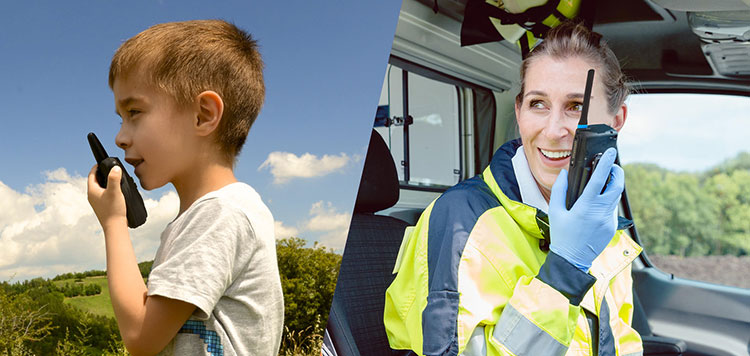A wireless walkie talkie, which operates within a broad frequency range, is generally referred to as a walkie talkie device when it functions in the Very High Frequency (VHF) range of 30 to 300 MHz or the Ultra High Frequency (UHF) range of 300 to 3000 MHz. Walkie talkies can be categorized in various ways based on their usage, including handheld, mobile (vehicle, marine, aircraft), fixed, and repeater types. Do you know how to use a walkie talkie correctly? In addition to protecting the antenna, what other precautions should be taken into account?

Principles of a Walkie talkie:
1. Transmitting Section:
The transmitting section of a walkie talkie utilizes a Phase-Locked Loop (PLL) and a Voltage-Controlled Oscillator (VCO) to generate the RF (Radio Frequency) carrier signal for transmission. After initial generation, the RF signal undergoes buffering, amplification, and power amplification stages to achieve the desired RF power level. The signal then passes through an antenna low-pass filter to suppress harmonic components before being transmitted via the antenna.
2. Receiving Section:
In the receiving section, the amplified RF signal is mixed with the first local signal generated by the Phase-Locked Loop frequency synthesizer circuit in the first mixer. This process results in the generation of a first Intermediate Frequency (IF) signal. The first IF signal passes through a crystal filter to further eliminate adjacent channel interference. Following filtering, the first IF signal enters an IF processing chip, where it undergoes a second mixing step with the second local signal, generating a second IF signal. The second IF signal is subjected to ceramic filtering to eliminate unwanted spurious signals and is subsequently amplified and demodulated to produce an audio signal. This audio signal passes through amplification, bandpass filtering, de-emphasis, and other circuitry, eventually entering volume control circuits and power amplifiers, which drive the speaker to provide the desired audio output.
3. Modulation Signal and Modulation Circuit:
Human voice, captured by the microphone, is transformed into an audio electrical signal.
4. Signaling Processing:
The CPU generates CTCSS/CDCSS (Continuous Tone-Coded Squelch System / Continuous Digital Coded Squelch System) signals, which are then amplified and adjusted before entering the Voltage-Controlled Oscillator for modulation. The low-frequency signal obtained after demodulation is partially amplified and filtered through sub-audio bandpass filtering to further shape the signal. It then enters the CPU for comparison with preset values. The results of this comparison control the audio amplifier and speaker output. In other words, if the signal matches the preset value, the speaker is activated; if not, it is deactivated.
How to Properly Use a Walkie talkie:
1. Handle the radio correctly; avoid gripping only the antenna or externally attaching a microphone to lift the radio.
2. Use a lint-free cloth to clean the battery contacts to remove dust, oil, or other substances to ensure a good circuit connection.
3. When not using an external earpiece, securely cover the dust cover and refrain from using paper or other objects to block the earpiece hole.
4. Do not use chemicals such as alcohol, sprays, or petroleum-based products to clean the radio (as they may be harmful and damage the radio housing and cover).
5. When in standby mode, refrain from pressing the Push-To-Talk (PTT) button.
7. Maintain a distance of 2.5-5 centimeters between the microphone and your mouth, and keep a minimum distance of 2.5-5 centimeters between the antenna and your head or body.
8. Ensure proper battery charging, and do not use the radio when the battery is low.
9. Do not attempt to disassemble the radio if it malfunctions.
10. When removing the battery, be sure to turn off the radio first.
11. During communication, keep your messages brief and concise, avoiding long transmissions.
12. If the radio gets wet, immediately power it off and remove the battery, then promptly send it for repair.
13. Strictly avoid using the radio without an antenna to prevent premature damage to the power amplifier and other components.

